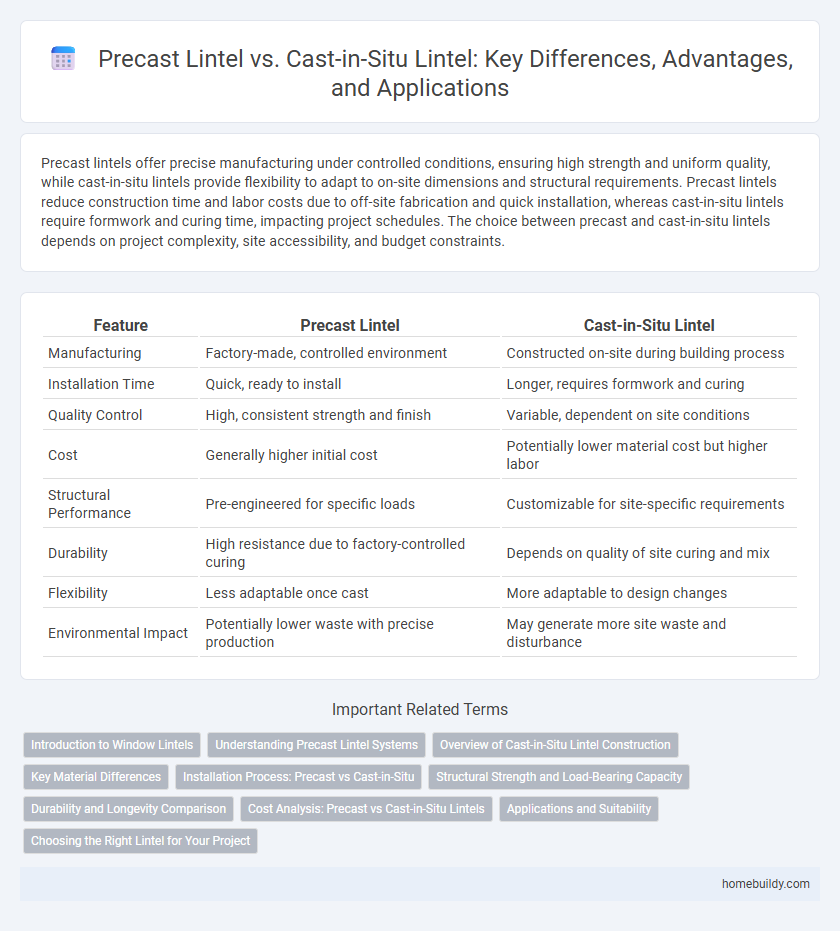Precast lintels offer precise manufacturing under controlled conditions, ensuring high strength and uniform quality, while cast-in-situ lintels provide flexibility to adapt to on-site dimensions and structural requirements. Precast lintels reduce construction time and labor costs due to off-site fabrication and quick installation, whereas cast-in-situ lintels require formwork and curing time, impacting project schedules. The choice between precast and cast-in-situ lintels depends on project complexity, site accessibility, and budget constraints.
Table of Comparison
| Feature | Precast Lintel | Cast-in-Situ Lintel |
|---|---|---|
| Manufacturing | Factory-made, controlled environment | Constructed on-site during building process |
| Installation Time | Quick, ready to install | Longer, requires formwork and curing |
| Quality Control | High, consistent strength and finish | Variable, dependent on site conditions |
| Cost | Generally higher initial cost | Potentially lower material cost but higher labor |
| Structural Performance | Pre-engineered for specific loads | Customizable for site-specific requirements |
| Durability | High resistance due to factory-controlled curing | Depends on quality of site curing and mix |
| Flexibility | Less adaptable once cast | More adaptable to design changes |
| Environmental Impact | Potentially lower waste with precise production | May generate more site waste and disturbance |
Introduction to Window Lintels
Window lintels provide essential structural support by spanning openings and distributing load from above to adjacent walls. Precast lintels are manufactured offsite under controlled conditions, ensuring consistent quality and faster installation, while cast-in-situ lintels are poured and cured directly at the construction site, allowing customization to exact dimensions. The choice between precast and cast-in-situ lintels depends on factors such as structural requirements, project timeline, and site conditions.
Understanding Precast Lintel Systems
Precast lintel systems offer enhanced quality control and faster installation compared to cast-in-situ lintels, as they are manufactured in controlled factory environments with precise dimensions and curing conditions. These systems reduce on-site labor and construction time while ensuring consistent strength and durability, making them ideal for repetitive structural elements in building construction. Precast lintels also minimize material waste and improve project scheduling by allowing simultaneous fabrication and site preparation.
Overview of Cast-in-Situ Lintel Construction
Cast-in-situ lintels are concrete beams cast directly at the construction site, providing seamless integration with masonry walls and superior structural continuity. This method allows for custom sizes and shapes, ensuring precise fitting and load distribution over window openings. The curing process requires formwork and reinforcement placement, enabling enhanced strength and durability compared to precast alternatives.
Key Material Differences
Precast lintels are typically made from high-strength concrete with controlled curing conditions, ensuring uniform quality and enhanced durability. Cast-in-situ lintels utilize concrete poured directly at the construction site, often incorporating site-specific aggregates and reinforcement tailored to the structural requirements. Steel reinforcement in precast lintels is pre-assembled and tensioned, while cast-in-situ lintels rely on on-site reinforcement placement and curing, influencing their mechanical properties and load-bearing capacity.
Installation Process: Precast vs Cast-in-Situ
Precast lintels offer a faster installation process since they are manufactured off-site and simply placed onto the window opening, reducing on-site labor and construction time. Cast-in-situ lintels require formwork, reinforcement setup, and concrete pouring directly at the site, which extends the installation timeline and demands skilled labor. The controlled factory environment in precast lintels ensures consistent quality and fewer onsite disruptions compared to the variability of cast-in-situ methods.
Structural Strength and Load-Bearing Capacity
Precast lintels offer consistent structural strength due to factory-controlled manufacturing, ensuring uniform quality and optimal curing conditions. Cast-in-situ lintels provide superior load-bearing capacity as they form a monolithic structure with adjacent walls, enhancing integration and reducing potential weak joints. Both types require proper reinforcement design to meet specific load requirements in construction projects.
Durability and Longevity Comparison
Precast lintels offer superior durability due to factory-controlled curing conditions, ensuring consistent strength and resistance to environmental stressors. Cast-in-situ lintels may be more susceptible to variations in weather and workmanship, potentially affecting their longevity. The enhanced material quality and controlled setting environment of precast lintels typically result in a longer lifespan compared to cast-in-situ alternatives.
Cost Analysis: Precast vs Cast-in-Situ Lintels
Precast lintels offer reduced labor costs and shorter installation times compared to cast-in-situ lintels due to factory-controlled manufacturing and standardized dimensions. Cast-in-situ lintels incur higher costs from on-site formwork, longer curing periods, and increased labor requirements, impacting overall project timelines and budgets. While precast lintels may involve higher initial material expenses, the expedited construction process and minimized site disruptions often result in lower total project costs.
Applications and Suitability
Precast lintels offer rapid installation and consistent quality, making them ideal for repetitive window openings in residential and commercial buildings. Cast-in-situ lintels provide greater flexibility for custom shapes and sizes, suited for complex architectural designs or irregular openings. Both types support load distribution effectively, but precast lintels are preferred for speed and durability, while cast-in-situ lintels excel in adaptability during construction.
Choosing the Right Lintel for Your Project
Precast lintels offer consistent quality and faster installation, ideal for projects requiring speed and uniformity, while cast-in-situ lintels provide greater flexibility in shape and size, suitable for customized architectural designs. Factors such as load-bearing requirements, site conditions, and construction timeline influence the choice between precast and cast-in-situ lintels. Assessing material durability, cost implications, and labor availability ensures the selection of the most efficient lintel type for structural integrity and project goals.
precast lintel vs cast-in-situ lintel Infographic

 homebuildy.com
homebuildy.com